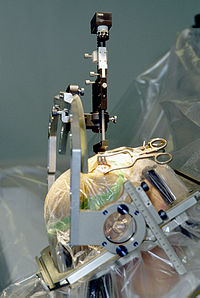
Photo from wikipedia
Background: Dexmedetomidine is widely used for conscious sedation in patients undergoing lower-extremity surgery under regional anesthesia. We evaluated the postoperative analgesic effects of intravenous dexmedetomidine given during ankle surgery under… Click to show full abstract
Background: Dexmedetomidine is widely used for conscious sedation in patients undergoing lower-extremity surgery under regional anesthesia. We evaluated the postoperative analgesic effects of intravenous dexmedetomidine given during ankle surgery under spinal anesthesia. Methods: Forty-three participants underwent repair of lateral angle ligaments under spinal anesthesia. For sedation during surgery, participants were allocated to a dexmedetomidine group (n=22) that received a loading dose of 1 mcg.kg−1 over 10 min, followed by a maintenance dose of 0.2–0.7 μg.kg−1.h−1; and a propofol group (n=21) that received an effective site concentration of 0.5–2.0 μg.mL−1 via target-controlled infusion. The primary outcome was the postoperative, cumulative, intravenous (IV) morphine equivalent dose delivered via IV patient-controlled anesthesia (PCA) and rescue analgesic consumption in the first 24 h after surgery. We recorded sensory and motor block durations. Results: The postoperative IV morphine equivalent dose was 14.5 mg (0.75–31.75 mg) in the dexmedetomidine group compared to 48.0 mg (31.5–92.5 mg) in the propofol group (median difference, 33.2 mg; 95% confidence interval, 21.0–54.8 mg; P<0.001). The time to the first complaint of surgical site pain was significantly prolonged in the dexmedetomidine group (P<0.001), but the duration of motor block was comparable between the two groups (P=0.55). Conclusion: IV dexmedetomidine given as a sedative during ankle surgery under spinal anesthesia reduced postoperative opioid consumption in the first 24 h. Thus, intraoperative dexmedetomidine is a versatile sedative adjunct. Level of evidence: Level I, prospective randomized trial.
Journal Title: Journal of Pain Research
Year Published: 2019
Link to full text (if available)
Share on Social Media: Sign Up to like & get
recommendations!